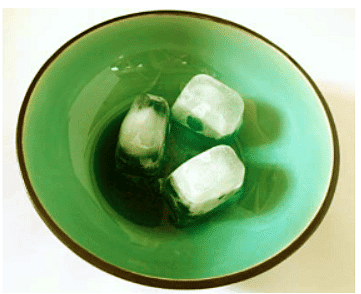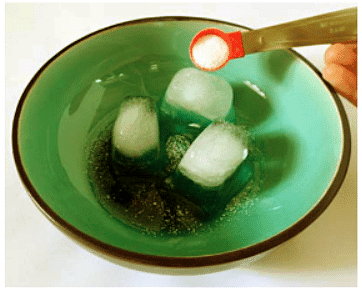Year 7 Exam > Year 7 Notes > What Makes Ice Melt Fastest?
What Makes Ice Melt Fastest? - Year 7 PDF Download
| Table of contents |

|
| Abstract |

|
| Objective |

|
| Introduction |

|
| Materials and Equipment |

|
| Experimental Procedure |

|
| Variations |

|
Abstract
If you live in a region prone to winter cold, you've likely observed trucks spreading a mix of sand and salt on roads after snowfall to aid in de-icing. Have you ever pondered the science behind this process? This fundamental chemistry project can offer some insights.
Objective
To determine which added material will make ice melt fastest.
Introduction
- If you have ever made homemade ice cream the traditional way using a hand-crank machine, you likely understand the necessity of ice and rock salt to sufficiently chill the cream mixture for freezing. Similarly, in colder regions, you may have noticed trucks spreading salt and sand on roads post-snowfall to prevent ice accumulation. In both scenarios, salt functions by reducing the freezing point of water, transforming solid ice into liquid water.
- For ice cream making, the rock salt lowers the ice's freezing point, enabling the ice/rock salt mixture to dip below the typical freezing point of water. Consequently, this facilitates freezing the ice cream mix within the ice cream machine's inner container. In the context of road salt application, the reduced freezing point allows snow and ice to melt despite sub-freezing temperatures. Both instances exemplify freezing point depression.
- Common table salt (sodium chloride or NaCl) dissolved in water represents a chemical solution. In a solution, there exists a solvent (e.g., water) and a solute (e.g., salt). Solute molecules dissolve due to a stronger attraction between solute and solvent molecules compared to intra-solute attractions. Water, being partially polarized, serves as a good solvent due to its partial charge distribution. This polarization enables water molecules to orient around ions like sodium (Na) and chloride (Cl-) ions constituting table salt, fostering dissolution and forming a saline solution.
- Other substances, when mixed with water, can lower its freezing point. The extent of this lowering is determined solely by the number of dissolved molecules, irrespective of their chemical composition. This phenomenon is known as a colligative property. In this experiment, we will explore various substances to observe their impact on the rate of ice melting. We will examine both soluble substances like salt and sugar, along with an insoluble substance such as sand. Which substances do you think will accelerate the ice melting process?
Materials and Equipment
- Identical bowls or saucers (4)
- Ice cubes (12). They should all be the same size and shape.
- Salt (¾ tsp.)
- Sugar (¾ tsp.)
- Sand (¾ tsp.)
- ¼ teaspoon measuring spoon
- Timer or clock
- Refrigerator. You will want an empty shelf that can hold all four bowls, unstacked, at the same time.
- 50 mL graduated cylinder, or smaller size.
- Large cup with a spout, such as some measuring cups. Alternatively, you could use a funnel that fits in the graduated cylinder.
- Optional: Masking tape and a permanent marker for labeling the bowls
- Lab notebook
Experimental Procedure
- Prepare the salt, sugar, sand, and measuring teaspoon.
- Set up ice cubes in four bowls, arranging three ice cubes in each bowl to form a triangular shape.

- Sprinkle ½ teaspoon of salt, sugar, sand, or nothing over the ice cubes in each bowl accordingly.

- Move the bowls to an empty shelf in the refrigerator.
- Note the starting time and periodically check the ice cubes until at least half melted.
- Make a data table in your lab notebook to record the amount of melted ice and remaining ice for each substance.

- Pour the melted water from each bowl into a graduated cylinder to measure the amount melted.
- Repeat step 7 for the remaining bowls.
- After all ice cubes are melted, repeat steps 7-8 to measure the remaining ice.
- Calculate the total amount of water (originally in ice cube form) for each bowl.
- Calculate the percentage of ice melted for each substance.
- Repeat the experiment at least two more times for multiple trials.
- Analyze the results to determine if any substances consistently speed up the ice melting process compared to plain ice cubes.
- Use the collected data to create a science fair display board.
Variations
- Does the rate at which ice melts change based on the added solute amount? Conduct an experiment to explore this.
- Study how temperature affects the melting of ice due to colligative properties. Experiment at various temperatures like room temperature or a hot outdoor setting. Remember to monitor the temperature consistently during the experiment.
- Are there other substances that can accelerate or decelerate the melting of ice cubes? Identify some substances for testing and repeat the experiment.
- For a related, more advanced exploration into freezing point depression, refer to the Science Buddies project titled Chemistry of Ice-Cream Making: Lowering the Freezing Point of Water.
- Do you believe salt can melt ice in your freezer? Why or why not? Test it out to find the answer.
FAQs on What Makes Ice Melt Fastest? - Year 7
| 1. What factors contribute to the speed at which ice melts? |  |
Ans. Factors such as temperature, surface area, and the presence of substances like salt or sugar can influence how quickly ice melts.
| 2. How does temperature affect the melting rate of ice? |  |
Ans. Higher temperatures provide more energy to break the bonds holding the ice molecules together, causing the ice to melt faster.
| 3. Why does adding salt or sugar to ice make it melt faster? |  |
Ans. Salt or sugar lowers the freezing point of water, causing the ice to melt at a lower temperature than usual.
| 4. Does the shape or size of the ice affect how quickly it melts? |  |
Ans. Yes, ice with a larger surface area will melt faster as it is exposed to more heat from its surroundings.
| 5. Can stirring or agitating the ice affect its melting rate? |  |
Ans. Yes, stirring or agitating the ice can help distribute heat more evenly, causing it to melt faster.
Related Searches


















